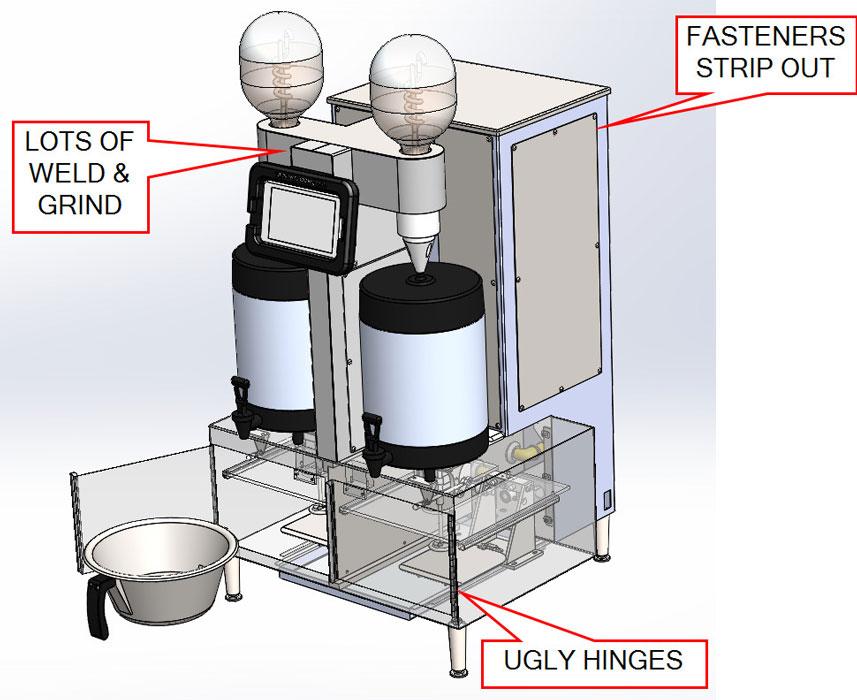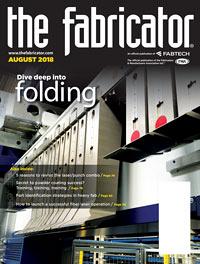Contributing Writer
- FMA
- The Fabricator
- FABTECH
- Canadian Metalworking
Categories
- Additive Manufacturing
- Aluminum Welding
- Arc Welding
- Assembly and Joining
- Automation and Robotics
- Bending and Forming
- Consumables
- Cutting and Weld Prep
- Electric Vehicles
- En Español
- Finishing
- Hydroforming
- Laser Cutting
- Laser Welding
- Machining
- Manufacturing Software
- Materials Handling
- Metals/Materials
- Oxyfuel Cutting
- Plasma Cutting
- Power Tools
- Punching and Other Holemaking
- Roll Forming
- Safety
- Sawing
- Shearing
- Shop Management
- Testing and Measuring
- Tube and Pipe Fabrication
- Tube and Pipe Production
- Waterjet Cutting
Industry Directory
Webcasts
Podcasts
FAB 40
Advertise
Subscribe
Account Login
Search
A 3-D CAD modeling case study: Using the prototype to develop a design for production
Check with the client before pursuing design improvements
- By Gerald Davis
- August 17, 2018
- Article
- Manufacturing Software
Disclaimer: This case study of a coffee maker’s sheet metal cabinet features a pair of inventors doing their best without the benefit of experience in manufacturing. The result was Voga Coffee Inc.’s commercial coffee maker that can fill a 1-gallon thermal carafe. In fact, the Specialty Coffee Association named the Ground Control® Cyclops™ batch coffee brewer the 2018 Best New Product, Commercial Equipment Award winner.
In the previous edition of this column (“A 3-D CAD modeling case study: What comes first—design for manufacturability or supply chain issues,” Precision Matters, The FABRICATOR®, July 2018, p. 38), the scope of design for manufacturability (DFM) needed to include planning for regulatory compliance. Every purchase, even at the early prototype stage, created inventory that had to be isolated as “noncompliant” from inventory that satisfied regulatory constraints. Similarly, choices made in subcontracting made an impact on inventory certification.
This edition relates another aspect of DFM: discovery of the problem. Previous episodes of this column have foreshadowed peril; my DFM work was oblivious to the industrial design (ID) investment that I was inheriting.
Even though my explorations in DFM were a bit off the mark, they are presented here as an example of the kind of effort that goes into a DFM project, particularly one involving ID.
Leave the Good
The overall DFM goals for this project were to make it smaller, less expensive, and easier to operate.
“Don’t throw the baby out with the bath water” is also good advice. It applies to DFM, as well. What worked as expected, which controls were delightful, and which features exceeded expectation—those constituted the DFM “baby” in this scenario.
Figures 1a and 1b show our bathing baby. The brewer makes excellent coffee. It does so very efficiently—and dramatically. Perhaps the greatest success in design is the top front of the machine. The glass and brushed stainless make a striking appearance. The machine is fascinating to watch as it brews. The location and layout of controls for brewing are similar to other brewers in this class and better than some of the competition. No major changes are needed to the layout of the machine.
Figures 1a and 1b elicit a different response from those expert in the fabrication trades. The basic observation is “lots of welding required.” A significant amount of welding and grinding are needed to close seams in the cabinet. Upon close examination, an experienced eye sees several flanges that are too short to bend easily, holes that distort because of closeness to bends, and screw threads that will strip out of thin sheet metal very easily. Plenty of “bath water” needs to be DFM’d out of the cabinet.
The prototype cabinet was very difficult to assemble. Sharp edges and small access zones were constant nuisances. Access for a wrench and driver was not planned for, and it showed. And that covered just some of the problems.
DFM: A “What If” Method
With a new invention, many unknowns exist. The prototype answered some questions and created others. If the DFM team knew all of the questions, the opportunity for making a perfect first-time design would have been almost possible. In this example, the DFM team did not know anything about coffee brewers, but it did know a good deal about sheet metal.
A plan of action was made based upon the prototype’s 3-D CAD in hand. Additionally, a few review meetings were held to discuss what the ideal coffee brewer cabinet would be. The DFM team wanted to present a concept for an easier-to-build cabinet and, after winning approval for the concept model, document how the appliance is made and produce drawings for fabrication and assembly.
From a CAD perspective, these concept models were intended to convey shape more than how-to-build. As more approval was gained, more detail was added.
With so many blessings and curses hurled at the prototype, I started with a wildly inspired shot at fixing everything. What if we really changed the hinges? What if we really changed the location of the control housing? After presenting the CAD model that solved all problems, I expected to be able to refine the design for final release quickly.
Here’s a valuable DFM tip: Check with the client to see if the “wildly inspired what if” is desirable. Perhaps a more subtle refinement is what is best. There’s more “baby” in there than you might expect. From Voga’s perspective, this entire “episode” could have been skipped, and we should have started with what we’ll describe in the next installment. Yep, that’s another do as I say, not as I do recommendation.
Figure 2a shows a first variation on the design. This sketch is beyond mere DFM. It actually launched into the realm of ID. But it seemed necessary to address the many fabrication cost overruns in the prototype.
The manufacturing goal was to subcontract small batches of custom parts through job shops, and then those parts would be assembled in-house. The ultimate goal, however, was to hand over all of the manufacturing to a contract manufacturer, but that was for the future.
To reduce welding at the top of the cabinet, the DFM team removed the blind return behind the bottles. The boxy shape of the rear tower was changed to a trapezoid, a shape that matches the need for width for the front pair of bowls and the relatively narrowness of the water tank. In this design, the removable top covers of the machine were the most difficult in terms of sheet metal; either stamped or welded, they concentrated the fabrication challenge.
In the prototype, the hinges for the front doors added width to the cabinet. Also shown in Figure 2a is an attempt to replace piano hinges with pivots formed from the doors themselves.
Figure 2b shows a variation on the variation—a version that has no doors. This was the easiest way to take 1/2 in. off the cabinet width. This design took a bit of a leap when it came to tooling expense, with the requirement for the large bend radii, but it seemed like an idea that might have merit.
Present Arms
I presented these design ideas in a review meeting. My skilled use of 3-D CAD in a live demo helped to bring out the opportunities for a better design.
I thought it best to put the service door for the electronics on the back wall of the tower. That idea was nixed because, when the brewer is installed, a maintenance person does not have access to the back of the machine.
I thought removing the hinged doors would be a good cost savings. However, the doors served to trap heat and steam. An open front was not a good idea.
I thought that putting all of the tooling expense into the top lids and having lips on the lids was good. It turned out that the lid design on the prototype was really not loved. Something entirely different was needed.
I thought that the changes I offered were pretty subtle. The industrial designers who worked on the prototype felt that I had ignored the golden ratio of the design and had missed the goal of making the tower “disappear.”
The conclusions from that review meeting included:
- I have the ability to model anything. They need for me to stop modeling everything I can imagine and start modeling something they want.
- The doors were a bad idea. Find a different solution.
- Plan for service access and then design the main tower.
The good news was that the team was excited to be able to discuss the design in detail. The virtual models were a wonderful tool for discovery of the ideal. Also, the design review meeting was very productive, although the design was not completed. If there was bad news, it was that the industrial design that was thought to be complete was completely undone, at least in the minds of the industrial designers.
In the next episode we continue the refinement of the cabinet’s design. The process of prototype, review, redesign, and approval of a working prototype is necessary prior to release for mass production. Will DFM and ID find happiness together? Gerald would love for you to send him your comments and questions. You are not alone, and the problems you face often are shared by others. Share the grief, and perhaps we will all share in the joy of finding answers. Please send your questions and comments to dand@thefabricator.com.
Please send your questions and comments to dand@thefabricator.com.
About the Author
subscribe now

The Fabricator is North America's leading magazine for the metal forming and fabricating industry. The magazine delivers the news, technical articles, and case histories that enable fabricators to do their jobs more efficiently. The Fabricator has served the industry since 1970.
start your free subscription- Stay connected from anywhere

Easily access valuable industry resources now with full access to the digital edition of The Fabricator.

Easily access valuable industry resources now with full access to the digital edition of The Welder.

Easily access valuable industry resources now with full access to the digital edition of The Tube and Pipe Journal.
- Podcasting
- Podcast:
- The Fabricator Podcast
- Published:
- 04/16/2024
- Running Time:
- 63:29
In this episode of The Fabricator Podcast, Caleb Chamberlain, co-founder and CEO of OSH Cut, discusses his company’s...
- Industry Events
16th Annual Safety Conference
- April 30 - May 1, 2024
- Elgin,
Pipe and Tube Conference
- May 21 - 22, 2024
- Omaha, NE
World-Class Roll Forming Workshop
- June 5 - 6, 2024
- Louisville, KY
Advanced Laser Application Workshop
- June 25 - 27, 2024
- Novi, MI

































